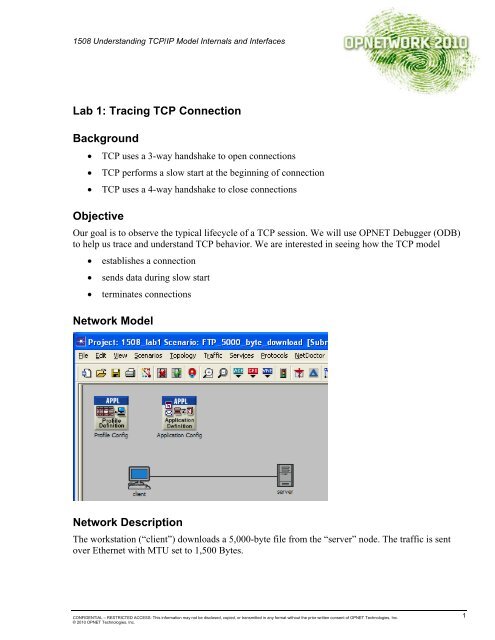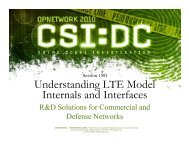Understanding TCP/IP Model Internals and Interfaces
Understanding TCP/IP Model Internals and Interfaces
Understanding TCP/IP Model Internals and Interfaces
Create successful ePaper yourself
Turn your PDF publications into a flip-book with our unique Google optimized e-Paper software.
1508 <strong>Underst<strong>and</strong>ing</strong> <strong>TCP</strong>/<strong>IP</strong> <strong>Model</strong> <strong>Internals</strong> <strong>and</strong> <strong>Interfaces</strong><br />
Lab 1: Tracing <strong>TCP</strong> Connection<br />
Background<br />
• <strong>TCP</strong> uses a 3-way h<strong>and</strong>shake to open connections<br />
• <strong>TCP</strong> performs a slow start at the beginning of connection<br />
• <strong>TCP</strong> uses a 4-way h<strong>and</strong>shake to close connections<br />
Objective<br />
Our goal is to observe the typical lifecycle of a <strong>TCP</strong> session. We will use OPNET Debugger (ODB)<br />
to help us trace <strong>and</strong> underst<strong>and</strong> <strong>TCP</strong> behavior. We are interested in seeing how the <strong>TCP</strong> model<br />
• establishes a connection<br />
• sends data during slow start<br />
• terminates connections<br />
Network <strong>Model</strong><br />
Network Description<br />
The workstation (“client”) downloads a 5,000-byte file from the “server” node. The traffic is sent<br />
over Ethernet with MTU set to 1,500 Bytes.<br />
CONFIDENTIAL – RESTRICTED ACCESS: This information may not be disclosed, copied, or transmitted in any format without the prior written consent of OPNET Technologies, Inc.<br />
© 2010 OPNET Technologies, Inc.<br />
1
















